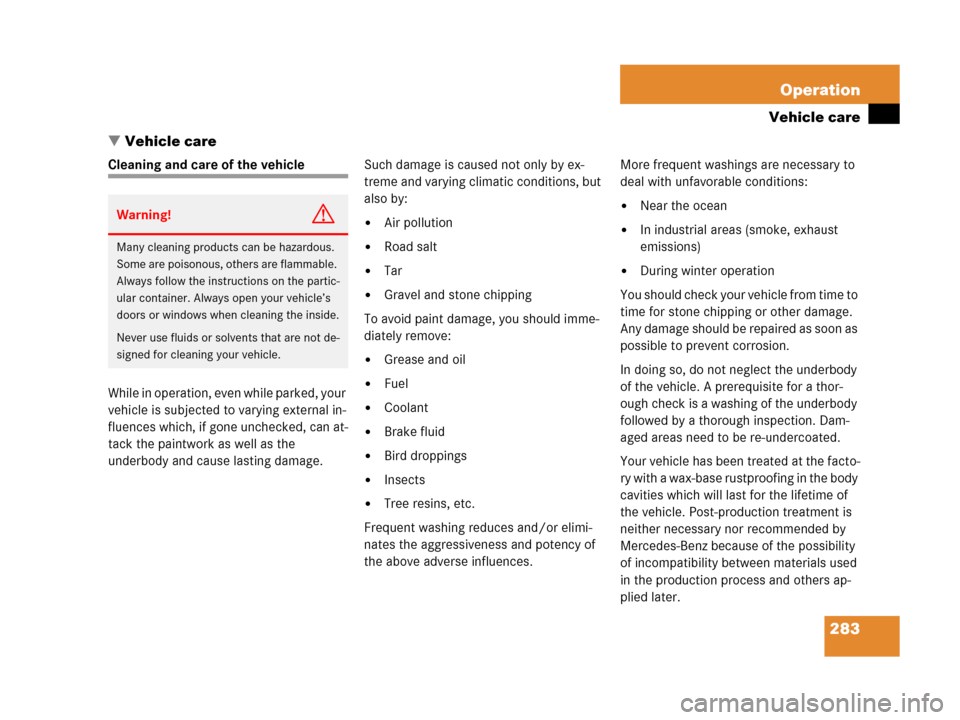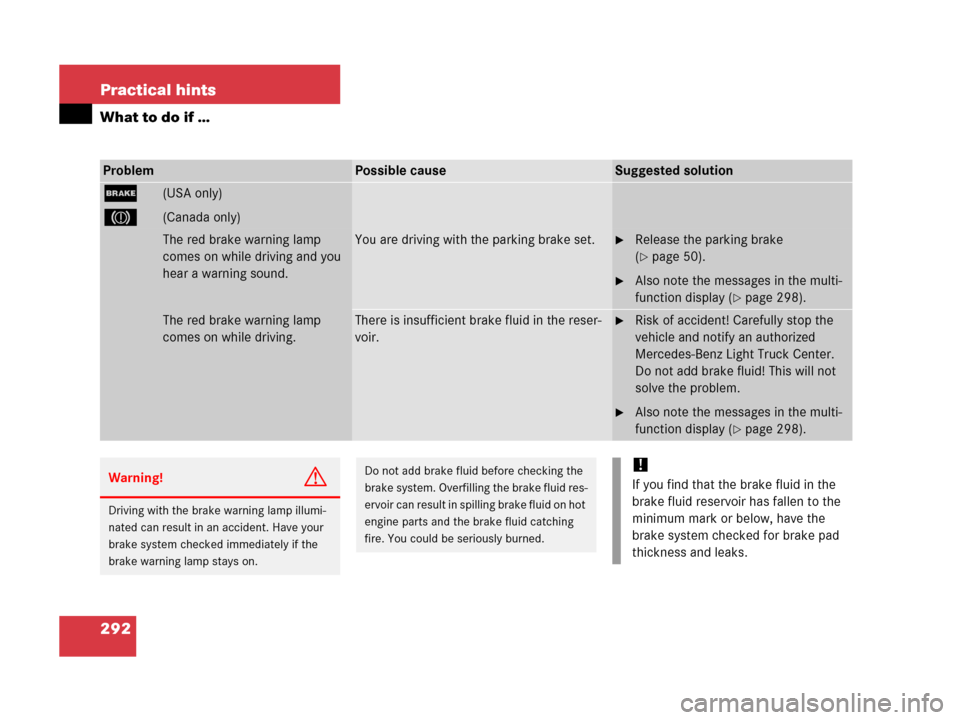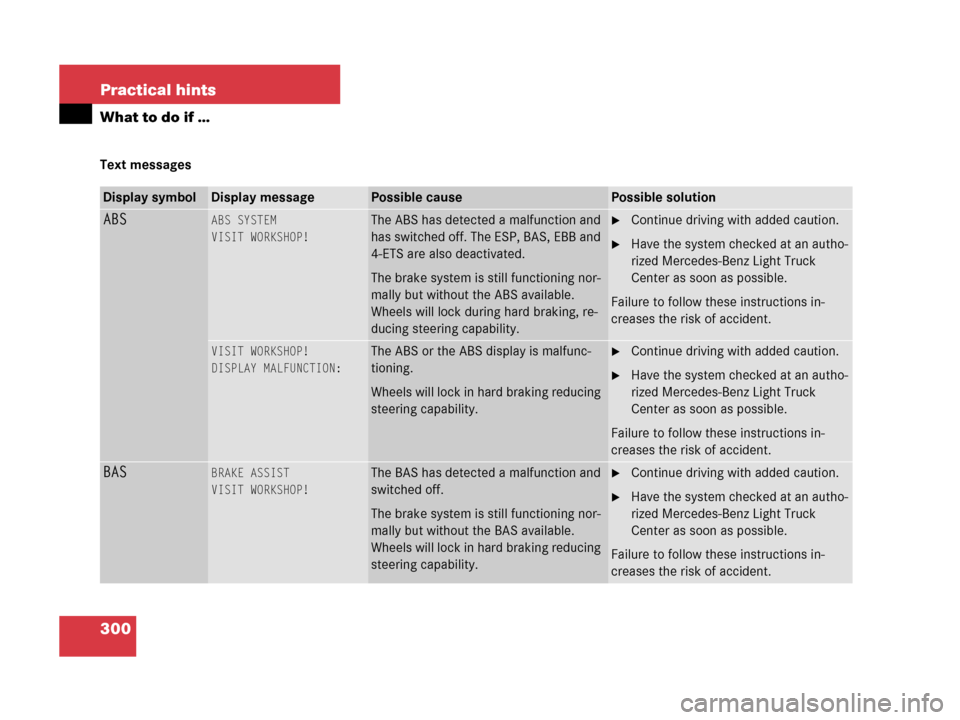Page 276 of 417

275 Operation
Tires and wheels
Production options weight
The combined weight of those installed
regular production options weighing over
5 lbs (2.3 kilograms) in excess of those
standard items which they replace, not
previously considered in curb weight or
accessory weight, including heavy duty
brakes, ride levelers, heavy duty battery,
and special trim.
PSI (P
ounds per square inch)
A standard unit of measure for air pressure
-> bar, kilopascal (kPa).
Recommended tire inflation pressure
Recommended tire inflation pressure
listed on placard located on driver’s door
B-pillar for normal driving conditions.
Provides best handling, tread life and
riding comfort.Rim
A metal support for a tire or a tire and tube
assembly upon which the tire beads are
seated.
Sidewall
The portion of a tire between the tread and
the bead.
TIN (Tire Identification Number)
Unique identifier which facilitates efforts
by tire manufacturers to notify purchasers
in recall situations or other safety matters
concerning tires and gives purchases the
means to easily identify such tires. The TIN
is comprised of “Manufacturer’s identifica-
tion mark”, “Tire size”, “Tire type code”
and “Date of manufacture”.
Tire load rating
Numerical code associated with the
maximum load a tire can support.Tire ply composition and material used
This indicates the number of plies or the
number of layers of rubber-coated fabric in
the tire tread and sidewall. Tire manufac-
turers also must indicate the ply materials
in the tire and sidewall, which include
steel, nylon, polyester, and others.
Tire speed rating
Part of tire designation; indicates the
speed range for which a tire is approved.
Traction
Force exerted by the vehicle on the road
via the tires. The amount of grip provided.
Tread
The portion of a tire that comes into
contact with the road.
Page 278 of 417
277 Operation
Tires and wheels
Rotate tires before the characteristic tire
wear pattern becomes visible (shoulder
wear on front tires and tread center wear
on rear tires).
Thoroughly clean the mounting face of
wheels and brake disks, i.e. the inner side
of the wheels/tires, during each rotation.
Check for and ensure proper tire inflation
pressure.
For information on wheel change, see “Flat
tire” (
�page 348).
Warning!G
Have the tightening torque checked after
changing a wheel. Wheels could become
loose if not tightened with a torque of
97 lb-ft (130 Nm).
Only use genuine Mercedes-Benz wheel
bolts specified for your vehicle’s rims.
Page 284 of 417

283 Operation
Vehicle care
�Vehicle care
Cleaning and care of the vehicle
While in operation, even while parked, your
vehicle is subjected to varying external in-
fluences which, if gone unchecked, can at-
tack the paintwork as well as the
underbody and cause lasting damage.Such damage is caused not only by ex-
treme and varying climatic conditions, but
also by:
�Air pollution
�Road salt
�Tar
�Gravel and stone chipping
To avoid paint damage, you should imme-
diately remove:
�Grease and oil
�Fuel
�Coolant
�Brake fluid
�Bird droppings
�Insects
�Tree resins, etc.
Frequent washing reduces and/or elimi-
nates the aggressiveness and potency of
the above adverse influences.More frequent washings are necessary to
deal with unfavorable conditions:
�Near the ocean
�In industrial areas (smoke, exhaust
emissions)
�During winter operation
You should check your vehicle from time to
time for stone chipping or other damage.
Any damage should be repaired as soon as
possible to prevent corrosion.
In doing so, do not neglect the underbody
of the vehicle. A prerequisite for a thor-
ough check is a washing of the underbody
followed by a thorough inspection. Dam-
aged areas need to be re-undercoated.
Your vehicle has been treated at the facto-
ry with a wax-base rustproofing in the body
cavities which will last for the lifetime of
the vehicle. Post-production treatment is
neither necessary nor recommended by
Mercedes-Benz because of the possibility
of incompatibility between materials used
in the production process and others ap-
plied later.
Warning!G
Many cleaning products can be hazardous.
Some are poisonous, others are flammable.
Always follow the instructions on the partic-
ular container. Always open your vehicle’s
doors or windows when cleaning the inside.
Never use fluids or solvents that are not de-
signed for cleaning your vehicle.
Page 291 of 417

290 Practical hints
What to do if …
Lamps in instrument clusterGeneral information:
If any of the following lamps in the instru-
ment cluster fails to come on during thebulb self-check when switching on ignition,
have the respective bulb checked and re-
placed if necessary.
ProblemPossible causeSuggested solution
-The yellow ABS indicator lamp
comes on while driving.You engaged the differential locks. The ABS,
ESP, BAS, EBB and 4-ETS are switched off. �The driving systems will switch on
again after the differential locks have
been disengaged.
The ABS has detected a malfunction and has
switched off. The ESP, BAS, EBB and 4-ETS
are also switched off (see messages in dis-
play).
If the ABS control unit is malfunctioning, oth-
er systems such as the navigation system or
Rear Parking Assist* may also malfunction.
The brake system is still functioning normally
but without the ABS available.�Continue driving with added caution.
Wheels will lock during hard braking
reducing steering capability.
�Read and observe messages in the
multifunction display (
�page 300).
�Have the system checked at an autho-
rized Mercedes-Benz Light Truck
Center as soon as possible.
Failure to follow these instructions in-
creases the risk of an accident.
Page 293 of 417

292 Practical hints
What to do if …
ProblemPossible causeSuggested solution
;(USA only)
3 (Canada only)
The red brake warning lamp
comes on while driving and you
hear a warning sound.You are driving with the parking brake set.�Release the parking brake
(
�page 50).
�Also note the messages in the multi-
function display (
�page 298).
The red brake warning lamp
comes on while driving.There is insufficient brake fluid in the reser-
voir.�Risk of accident! Carefully stop the
vehicle and notify an authorized
Mercedes-Benz Light Truck Center.
Do not add brake fluid! This will not
solve the problem.
�Also note the messages in the multi-
function display (
�page 298).
Warning!G
Driving with the brake warning lamp illumi-
nated can result in an accident. Have your
brake system checked immediately if the
brake warning lamp stays on.
Do not add brake fluid before checking the
brake system. Overfilling the brake fluid res-
ervoir can result in spilling brake fluid on hot
engine parts and the brake fluid catching
fire. You could be seriously burned.!
If you find that the brake fluid in the
brake fluid reservoir has fallen to the
minimum mark or below, have the
brake system checked for brake pad
thickness and leaks.
Page 294 of 417
293 Practical hints
What to do if …
ProblemPossible causeSuggested solution
;(USA only)
3 (Canada only)
-The red brake warning lamp and
the yellow ABS indicator lamp
come on when the engine is run-
ning and you hear a warning
sound for approximately five sec-
onds.
The EBB has detected a malfunction and has
s w i t c h e d o f f . Y o u s h o u l d b e p r e p a r e d f o r y o u r
vehicle to perform differently than normal
when braking. �Continue driving with added caution.
�Have the system checked at an autho-
rized Mercedes-Benz Light Truck
Center as soon as possible.
�Also note the messages in the multi-
function display (
�page 298).
Failure to follow these instructions in-
creases the risk of accidents.
Page 301 of 417

300 Practical hints
What to do if …
Text messages
Display symbolDisplay messagePossible causePossible solution
ABSABS SYSTEM
VISIT WORKSHOP!The ABS has detected a malfunction and
has switched off. The ESP, BAS, EBB and
4-ETS are also deactivated.
The brake system is still functioning nor-
mally but without the ABS available.
Wheels will lock during hard braking, re-
ducing steering capability.�Continue driving with added caution.
�Have the system checked at an autho-
rized Mercedes-Benz Light Truck
Center as soon as possible.
Failure to follow these instructions in-
creases the risk of accident.
VISIT WORKSHOP!
DISPLAY MALFUNCTION:The ABS or the ABS display is malfunc-
tioning.
Wheels will lock in hard braking reducing
steering capability.�Continue driving with added caution.
�Have the system checked at an autho-
rized Mercedes-Benz Light Truck
Center as soon as possible.
Failure to follow these instructions in-
creases the risk of accident.
BASBRAKE ASSIST
VISIT WORKSHOP!The BAS has detected a malfunction and
switched off.
The brake system is still functioning nor-
mally but without the BAS available.
Wheels will lock in hard braking reducing
steering capability.�Continue driving with added caution.
�Have the system checked at an autho-
rized Mercedes-Benz Light Truck
Center as soon as possible.
Failure to follow these instructions in-
creases the risk of accident.
Page 304 of 417
303 Practical hints
What to do if …
DisplayDisplay messagePossible causePossible solution
ESPESP
VISIT WORKSHOP!The ESP is switched off due to a malfunc-
tion or an interruption in the power sup-
ply.
The brake system is still functioning nor-
mally but without ESP, ABS and BAS avail-
able.
If in addition the ABS is malfunctioning,
only partial engine output will be avail-
able.�Continue driving with added caution.
�Have the system checked at an autho-
rized Mercedes-Benz Light Truck
Center as soon as possible.
Failure to follow these instructions in-
creases the risk of accident.